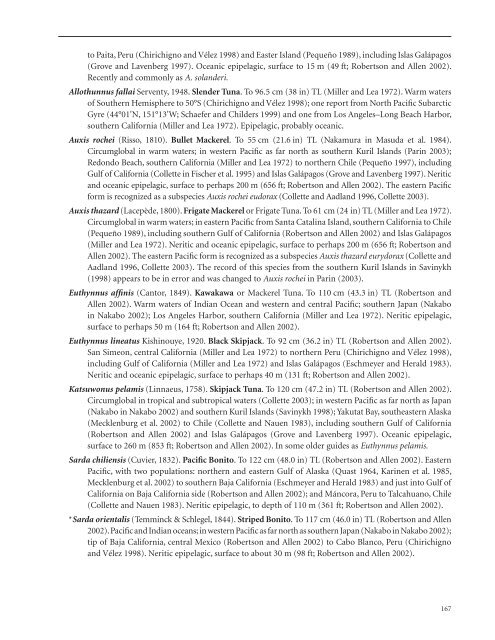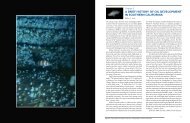checklist (pdf) - The Love Lab - University of California, Santa Barbara
checklist (pdf) - The Love Lab - University of California, Santa Barbara
checklist (pdf) - The Love Lab - University of California, Santa Barbara
You also want an ePaper? Increase the reach of your titles
YUMPU automatically turns print PDFs into web optimized ePapers that Google loves.
to Paita, Peru (Chirichigno and Vélez 1998) and Easter Island (Pequeño 1989), including Islas Galápagos<br />
(Grove and Lavenberg 1997). Oceanic epipelagic, surface to 15 m (49 ft; Robertson and Allen 2002).<br />
Recently and commonly as A. solanderi.<br />
Allothunnus fallai Serventy, 1948. Slender Tuna. To 96.5 cm (38 in) TL (Miller and Lea 1972). Warm waters<br />
<strong>of</strong> Southern Hemisphere to 50°S (Chirichigno and Vélez 1998); one report from North Pacific Subarctic<br />
Gyre (44°01'N, 151°13'W; Schaefer and Childers 1999) and one from Los Angeles–Long Beach Harbor,<br />
southern <strong>California</strong> (Miller and Lea 1972). Epipelagic, probably oceanic.<br />
Auxis rochei (Risso, 1810). Bullet Mackerel. To 55 cm (21.6 in) TL (Nakamura in Masuda et al. 1984).<br />
Circumglobal in warm waters; in western Pacific as far north as southern Kuril Islands (Parin 2003);<br />
Redondo Beach, southern <strong>California</strong> (Miller and Lea 1972) to northern Chile (Pequeño 1997), including<br />
Gulf <strong>of</strong> <strong>California</strong> (Collette in Fischer et al. 1995) and Islas Galápagos (Grove and Lavenberg 1997). Neritic<br />
and oceanic epipelagic, surface to perhaps 200 m (656 ft; Robertson and Allen 2002). <strong>The</strong> eastern Pacific<br />
form is recognized as a subspecies Auxis rochei eudorax (Collette and Aadland 1996, Collette 2003).<br />
Auxis thazard (Lacepède, 1800). Frigate Mackerel or Frigate Tuna. To 61 cm (24 in) TL (Miller and Lea 1972).<br />
Circumglobal in warm waters; in eastern Pacific from <strong>Santa</strong> Catalina Island, southern <strong>California</strong> to Chile<br />
(Pequeño 1989), including southern Gulf <strong>of</strong> <strong>California</strong> (Robertson and Allen 2002) and Islas Galápagos<br />
(Miller and Lea 1972). Neritic and oceanic epipelagic, surface to perhaps 200 m (656 ft; Robertson and<br />
Allen 2002). <strong>The</strong> eastern Pacific form is recognized as a subspecies Auxis thazard eurydorax (Collette and<br />
Aadland 1996, Collette 2003). <strong>The</strong> record <strong>of</strong> this species from the southern Kuril Islands in Savinykh<br />
(1998) appears to be in error and was changed to Auxis rochei in Parin (2003).<br />
Euthynnus affinis (Cantor, 1849). Kawakawa or Mackerel Tuna. To 110 cm (43.3 in) TL (Robertson and<br />
Allen 2002). Warm waters <strong>of</strong> Indian Ocean and western and central Pacific; southern Japan (Nakabo<br />
in Nakabo 2002); Los Angeles Harbor, southern <strong>California</strong> (Miller and Lea 1972). Neritic epipelagic,<br />
surface to perhaps 50 m (164 ft; Robertson and Allen 2002).<br />
Euthynnus lineatus Kishinouye, 1920. Black Skipjack. To 92 cm (36.2 in) TL (Robertson and Allen 2002).<br />
San Simeon, central <strong>California</strong> (Miller and Lea 1972) to northern Peru (Chirichigno and Vélez 1998),<br />
including Gulf <strong>of</strong> <strong>California</strong> (Miller and Lea 1972) and Islas Galápagos (Eschmeyer and Herald 1983).<br />
Neritic and oceanic epipelagic, surface to perhaps 40 m (131 ft; Robertson and Allen 2002).<br />
Katsuwonus pelamis (Linnaeus, 1758). Skipjack Tuna. To 120 cm (47.2 in) TL (Robertson and Allen 2002).<br />
Circumglobal in tropical and subtropical waters (Collette 2003); in western Pacific as far north as Japan<br />
(Nakabo in Nakabo 2002) and southern Kuril Islands (Savinykh 1998); Yakutat Bay, southeastern Alaska<br />
(Mecklenburg et al. 2002) to Chile (Collette and Nauen 1983), including southern Gulf <strong>of</strong> <strong>California</strong><br />
(Robertson and Allen 2002) and Islas Galápagos (Grove and Lavenberg 1997). Oceanic epipelagic,<br />
surface to 260 m (853 ft; Robertson and Allen 2002). In some older guides as Euthynnus pelamis.<br />
Sarda chiliensis (Cuvier, 1832). Pacific Bonito. To 122 cm (48.0 in) TL (Robertson and Allen 2002). Eastern<br />
Pacific, with two populations: northern and eastern Gulf <strong>of</strong> Alaska (Quast 1964, Karinen et al. 1985,<br />
Mecklenburg et al. 2002) to southern Baja <strong>California</strong> (Eschmeyer and Herald 1983) and just into Gulf <strong>of</strong><br />
<strong>California</strong> on Baja <strong>California</strong> side (Robertson and Allen 2002); and Máncora, Peru to Talcahuano, Chile<br />
(Collette and Nauen 1983). Neritic epipelagic, to depth <strong>of</strong> 110 m (361 ft; Robertson and Allen 2002).<br />
*Sarda orientalis (Temminck & Schlegel, 1844). Striped Bonito. To 117 cm (46.0 in) TL (Robertson and Allen<br />
2002). Pacific and Indian oceans; in western Pacific as far north as southern Japan (Nakabo in Nakabo 2002);<br />
tip <strong>of</strong> Baja <strong>California</strong>, central Mexico (Robertson and Allen 2002) to Cabo Blanco, Peru (Chirichigno<br />
and Vélez 1998). Neritic epipelagic, surface to about 30 m (98 ft; Robertson and Allen 2002).<br />
167




